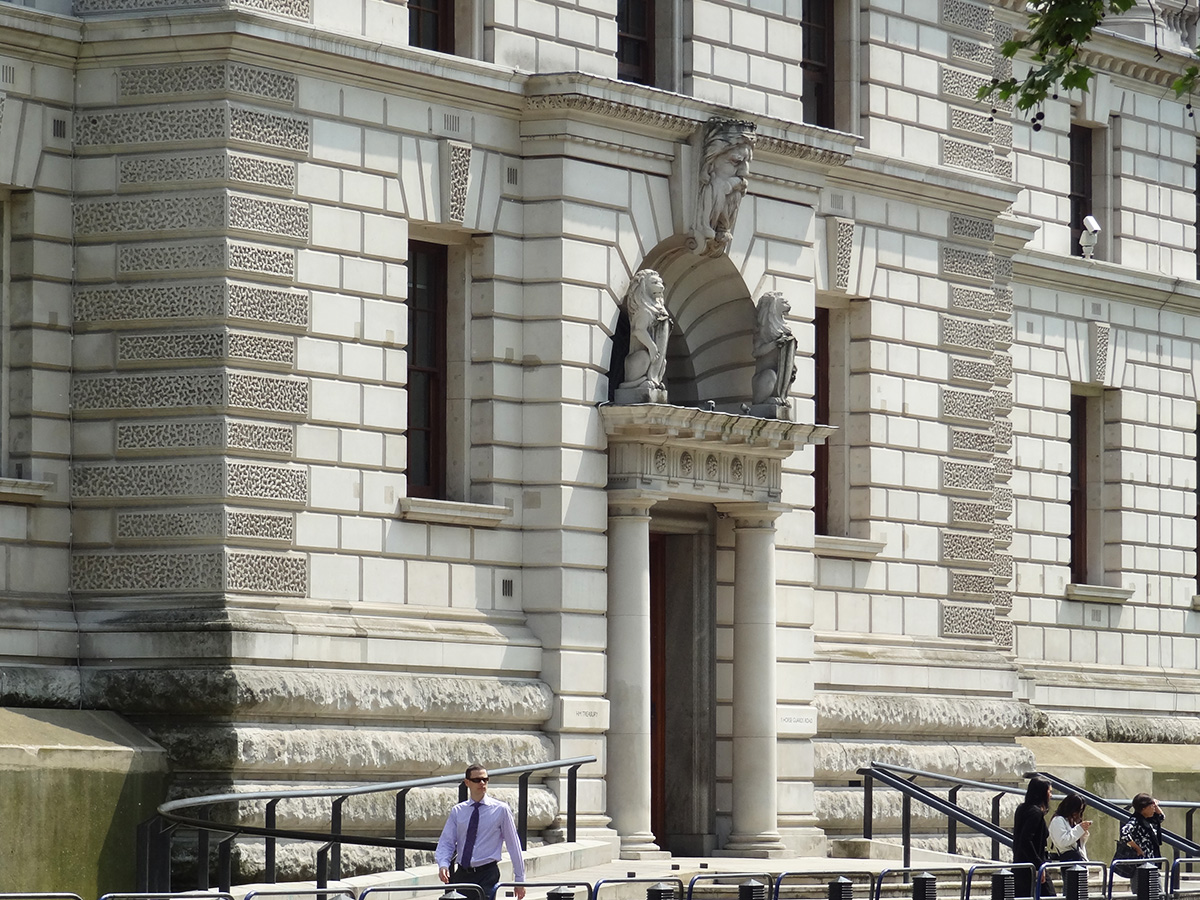 The UK government has made much of its spending commitments in the UK Budget and Spending Review delivered on 27 October 2021. Spending on transport infrastructure, green energy and health care figured prominently. The government claimed that these were to help achieve its objectives of economic growth, carbon reduction and ‘levelling up’. This means that government expenditure will be around 42% of GDP for the five years from 2022 (from 1988 to 2000 it averaged 36%). Although it temporarily rose to 52% in 2020/21, this was the result of supporting the economy through the pandemic. But does this mean that the government is now a ‘Keynesian’ one?
The UK government has made much of its spending commitments in the UK Budget and Spending Review delivered on 27 October 2021. Spending on transport infrastructure, green energy and health care figured prominently. The government claimed that these were to help achieve its objectives of economic growth, carbon reduction and ‘levelling up’. This means that government expenditure will be around 42% of GDP for the five years from 2022 (from 1988 to 2000 it averaged 36%). Although it temporarily rose to 52% in 2020/21, this was the result of supporting the economy through the pandemic. But does this mean that the government is now a ‘Keynesian’ one?
When the economy is in recession, as was the case in 2020 with the effects of the pandemic, increased government expenditure financed by borrowing rather than taxation is the classic Keynesian remedy to boost aggregate demand and close the output gap. The increased injection of spending works through the multiplier process to raise equilibrium national income and reduce unemployment.
But is this the objective of the extra spending announced in October 2021? To answer this, it is important to look at forecasts for the state of the economy with no change in government policy and at the balance of government expenditure and taxation resulting from the Budget. The first chart shows public sector net borrowing from 2006/7 and forecast to 2026/7. The green and red lines from 2021/22 onwards give the PSNB forecasts with and without the October 2021 measures.
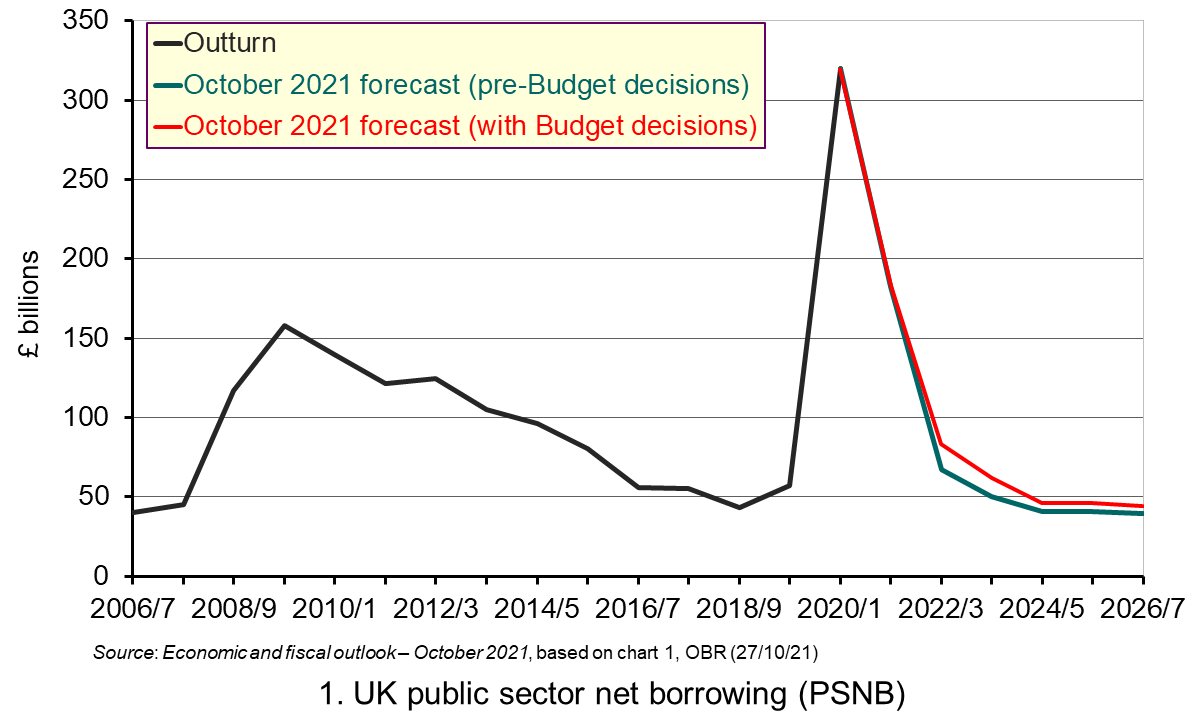 As you can see, there was a large increase in the PSNB in 2020/21, reflecting the government’s measures to support firms and workers during the pandemic. (Click here for a PowerPoint of the chart.) This was very much a Keynesian response, where a large budget deficit was necessary to support aggregate demand. It was also to protect the supply side of the economy by enabling firms to survive.
As you can see, there was a large increase in the PSNB in 2020/21, reflecting the government’s measures to support firms and workers during the pandemic. (Click here for a PowerPoint of the chart.) This was very much a Keynesian response, where a large budget deficit was necessary to support aggregate demand. It was also to protect the supply side of the economy by enabling firms to survive.
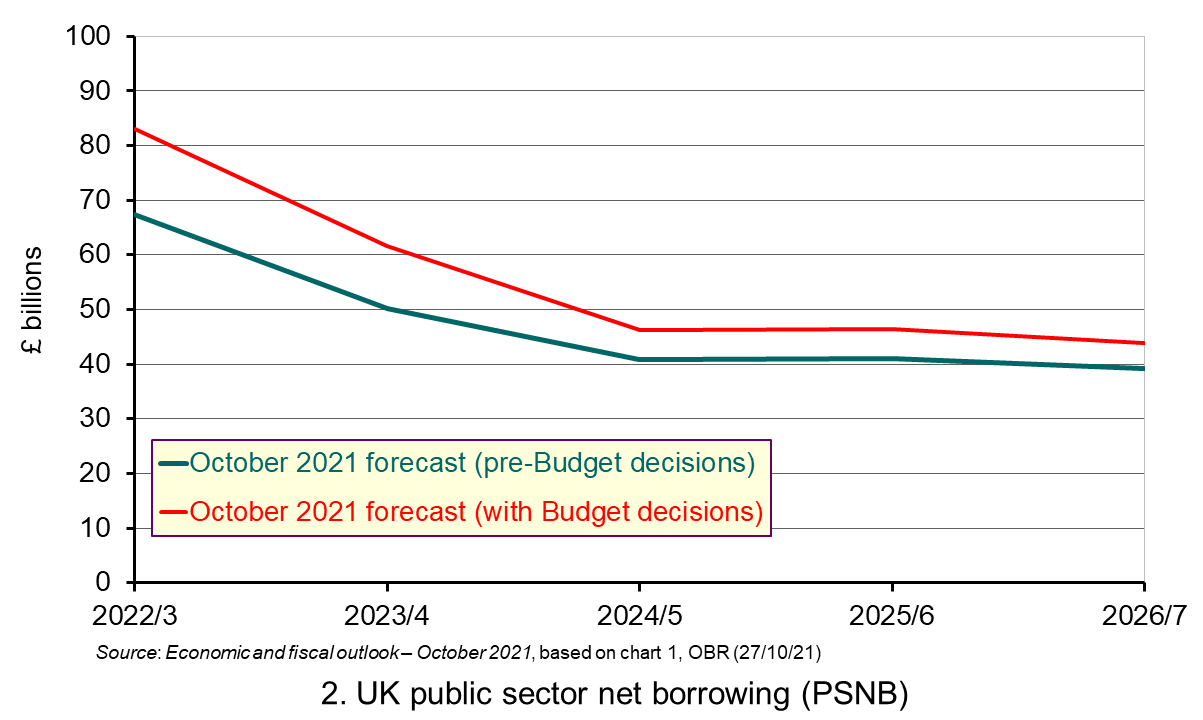 But could the October 2021 announcements also be seen as a Keynesian response to the macroeconomic situation? If we redraw Chart 1, focusing just on the forecast period and adjust the vertical scale, we can see that the measures have a net effect of increasing the PSNB and thus acting as a stimulus to aggregate demand. (Click here for a PowerPoint of the chart.) The figures are shown in the following table, which shows the totals from Table 5.1 in the Autumn Budget and Spending Review 2021 document:
But could the October 2021 announcements also be seen as a Keynesian response to the macroeconomic situation? If we redraw Chart 1, focusing just on the forecast period and adjust the vertical scale, we can see that the measures have a net effect of increasing the PSNB and thus acting as a stimulus to aggregate demand. (Click here for a PowerPoint of the chart.) The figures are shown in the following table, which shows the totals from Table 5.1 in the Autumn Budget and Spending Review 2021 document:
Effects of Spending Review and Budget 2021 on PSNB (+ = increase in PSNB)

At first sight, it would seem that the Budget was mildly expansionary. To see how much so, the Office for Budget Responsibility (OBR) measures the ‘fiscal stance’ using the ‘cyclically adjusted primary deficit (CAPD)’. This is PSNB minus interest payments and minus expenditures and tax revenues that fluctuate with the cycle and which therefore act as automatic stabilisers. The OBR’s forecast of the CAPD shows it to be expansionary, but decreasing over time. In 2021/22, there is forecast to be a net injection of around 3.2% (excluding ‘virus-related’ support), falling to 2.7% in 2022/23 and then gradually to around 0.6% by 2026/27. So it does seem that fiscal policy remains expansionary throughout the period, but less and less so.
But this alone does not make it ‘Keynesian’. A Keynesian Budget would be one that uses fiscal policy to adjust aggregate demand (AD) according to whether AD is forecast to be deficient or excessive without the Budget measures. To operate a Keynesian Budget, it would be necessary to forecast the output gap without any policy measures. If was forecast to be negative (a deficiency of demand, with equilibrium output below the potential level), then an expansionary policy should be pursued by raising government expenditure, cutting taxes or some combination of the two. If it was forecast to be positive (an excess demand, with equilibrium output above the potential level), then a contractionary/deflationary policy should be pursued by cutting government expenditure, raising taxes or some combination of the two.
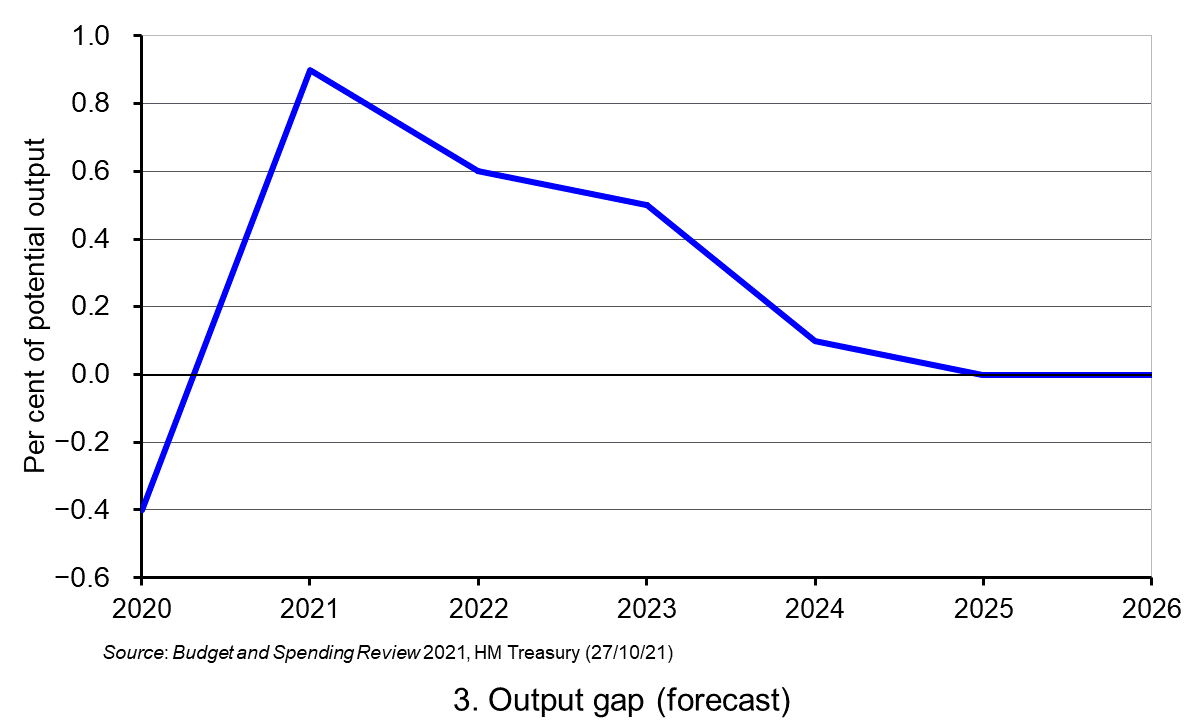 So what is the forecast for the output gap? The OBR states that, after being negative in 2020
So what is the forecast for the output gap? The OBR states that, after being negative in 2020
(–0.4% of potential GDP), it has risen substantially to 0.9% in 2021 with the rapid bounce back from the pandemic. But it is forecast to remain positive, albeit declining, until reaching zero in 2025. This is illustrated in Chart 3. (Click here for a PowerPoint of the chart.) So fiscal policy remains mildly expansionary until 2025, after having provided a considerable stimulus in 2021.
This is not normally what a Keynesian economist would recommend. Fiscal policy should be designed to achieve a zero output gap. With the output gap being substantially positive in 2021, there is a problem of excess demand. This can be seen in supply-chain difficulties and labour shortages in certain areas and higher inflation, with CPI inflation predicted by the OBR to rise to 4.4 per cent in 2022. The combination of higher prices, the rise in national insurance from April 2022 by 1.25 percentage points and the freezing of income tax personal allowances will squeeze living standards. And the cancelling of the £20 per week uplift to Universal Credit and no increase in its rate for the unemployed will put particular pressure on some of the poorest people.
 The government is hoping that the rise in government expenditure will have beneficial supply-side effects and increase potential national income. The aim is to create a high-wage, high-skilled, high-productivity economy though investment in innovation, infrastructure and skills. As the OBR states, ‘The rebounding economy has provided the Chancellor with a Budget windfall that he has added to with tax rises that lift the tax burden to its highest since the early 1950s’.
The government is hoping that the rise in government expenditure will have beneficial supply-side effects and increase potential national income. The aim is to create a high-wage, high-skilled, high-productivity economy though investment in innovation, infrastructure and skills. As the OBR states, ‘The rebounding economy has provided the Chancellor with a Budget windfall that he has added to with tax rises that lift the tax burden to its highest since the early 1950s’.
It remains to be seen whether the extra spending on education, training, infrastructure and R&D will be sufficient to achieve the long-term growth the Chancellor is seeking. The OBR is forecasting very modest growth into the longer term when the bounce back has worked through. Real GDP is forecast to grow on average by just 1.5% per year from 2024 to 2026. What is more, the OBR sees permanent scarring effects of around 2% of GDP from the pandemic and around 4% of GDP from Brexit.
Articles
Analysis
Documents
Data
Questions
- What do you understand by ‘fiscal stance’?
- What are ‘automatic fiscal stabilisers? How might they affect GDP over the next few years?
- If the government had chosen to pursue a zero output gap from 2022/23 onwards, how would this have affected the balance between total government expenditure and taxation in the 2021 Budget and Spending Review?
- Provide a critique of the Budget from the left.
- Provide a critique of the budget from the right.
- Was this a ‘Green Budget’?
- Is the Budget following the ‘golden rule’ of fiscal policy?
- Look through Table 5.1 in the Budget and Spending Review document (linked below). Which of the measures will have the most substantial effect on aggregate demand?
 One of the major economic concerns about the COVID-19 pandemic has been the likely long-term scarring effects on economies from bankruptcies, a decline in investment, lower spending on research and development, a loss of skills, discouragement of workers, disruption to education, etc. The result would be a decline in potential output or, at best, a slower growth. These persistent effects are known as ‘hysteresis’ – an effect that persists after the original cause has disappeared.
One of the major economic concerns about the COVID-19 pandemic has been the likely long-term scarring effects on economies from bankruptcies, a decline in investment, lower spending on research and development, a loss of skills, discouragement of workers, disruption to education, etc. The result would be a decline in potential output or, at best, a slower growth. These persistent effects are known as ‘hysteresis’ – an effect that persists after the original cause has disappeared.
In a speech by Dave Ramsden, the Bank of England’s Deputy Governor for Markets & Banking, he argued that, according to MPC estimates, the pandemic will have caused a loss of potential output of 1.75%. This shortfall may seem small at first sight, so does it matter? According to Ramsden:
The answer is definitely yes for two reasons. First, a 1¾% shortfall as a share of annual GDP for the UK … represents roughly £39 billion – for context, that’s about half of the education budget. And second, that 1¾% represents a permanent shortfall, or at least a very persistent one, on top of the impact of the immediate downturn. If you lose 1¾% of GDP every year for ten years, then in total you have lost 17.5% of one year’s GDP, or around £390bn in 2019 terms
However, as the IMF blog linked below argues, there may be positive supply-side effects which outweigh these scarring effects, causing a net rise in potential GDP growth. There are two possible reasons for this.
 The first is that the pandemic may have hastened the process of digitalisation and automation. Examples include ‘video conferencing and file sharing applications to drones and data-mining technologies’. According to evidence from a sample of 15 countries cited in the blog, a 10% rise in such intangible capital investment is associated with about a 4½% rise in labour productivity. ‘As COVID-19 recedes, the firms which invested in intangible assets, such as digital technologies and patents may see higher productivity as a result.’
The first is that the pandemic may have hastened the process of digitalisation and automation. Examples include ‘video conferencing and file sharing applications to drones and data-mining technologies’. According to evidence from a sample of 15 countries cited in the blog, a 10% rise in such intangible capital investment is associated with about a 4½% rise in labour productivity. ‘As COVID-19 recedes, the firms which invested in intangible assets, such as digital technologies and patents may see higher productivity as a result.’
The second is a reallocation of workers and capital to more productive sectors. Firms in some sectors, such as leisure, hospitality and retail, have relatively low labour productivity. Many parts of these industries have declined during the pandemic, especially those with high labour intensity. At the same time, there has been a rise in employment in firms where output per worker is higher. Such sectors include e-commerce and those where remote working is possible. The greater the reallocation from low labour-productivity to high labour-productivity sectors, the more will overall labour productivity rise and hence the more will potential output increase.
The size of these two effects will depend to a large extent on expectations, incentives and government policy. The blog cites four types of policy that can help investment and reallocation.
- Improved insolvency and restructuring procedures to enable capital in failed firms to be reallocated to sectors with potential for growth.
- Promoting competition to enable the exit and entry of firms into expanding sectors and to prevent powerful firms from blocking the process.
- Refocusing policy from retaining labour in existing jobs to reskilling workers for new jobs, thereby improving labour mobility from declining to expanding sectors.
- Addressing financial bottlenecks, so as to ensure adequate access to financing for viable firms.
Whether there will be a net increase or decrease in productivity from the pandemic very much depends on the extent to which firms and workers are able and willing to take advantage of new opportunities and the extent to which government supports investment in and reallocation to high-productivity sectors.
Blogs, articles and speeches
Questions
- Can actual economic growth be greater than potential economic growth (a) in the short run; (b) in the long run?
- Give some example of scarring effects from the COVID-19 pandemic.
- What effects might short-term policies to tackle the recession caused by the pandemic have on longer-term potential economic growth?
- What practical policies could governments adopt to encourage the positive supply-side effects of the pandemic? To what extent would these policies have negative short-term effects?
- Why might (endogenous) financial crises result in larger and more persistent reductions in potential output than exogenous crises, such as a pandemic or a war?
- Distinguish between interventionist and market-orientated supply-side policies to encourage the reallocation of labour and capital to higher-productivity sectors.
 The OECD has recently published its six-monthly Economic Outlook. This assesses the global economic situation and the prospects for the 38 members of the OECD.
The OECD has recently published its six-monthly Economic Outlook. This assesses the global economic situation and the prospects for the 38 members of the OECD.
It forecasts that the UK economy will bounce back strongly from the deep recession of 2020, when the economy contracted by 9.8 per cent. This contraction was deeper than in most countries, with the USA contracting by 3.5 per cent, Germany by 5.1 per cent, France by 8.2 per cent, Japan by 4.7 per cent and the OECD as a whole by 4.8 per cent. But, with the success of the vaccine roll-out, UK growth in 2021 is forecast by the OECD to be 7.2 per cent, which is higher than in most other countries. The USA is forecast to grow by 6.8 per cent, Germany by 3.3 per cent, France by 5.8 per cent, Japan by 2.6 per cent and the OECD as a whole by 5.3 per cent. Table 1 in the Statistical Annex gives the figures.
This good news for the UK, however, is tempered by some worrying features.
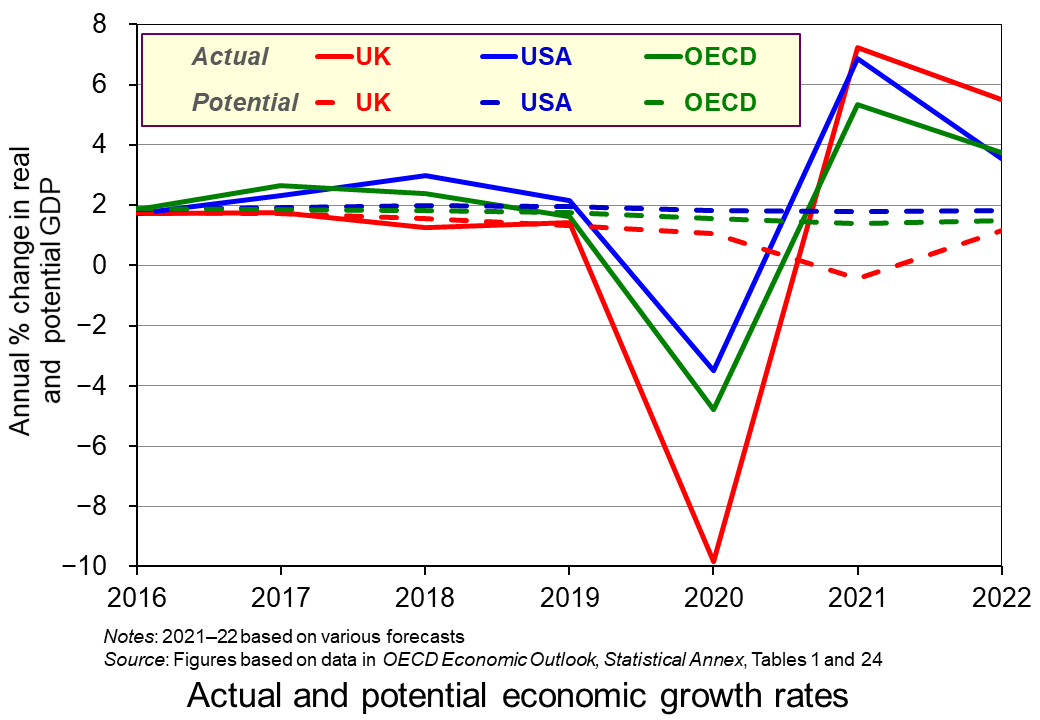 The OECD forecasts that potential economic growth will be negative in 2021, with capacity declining by 0.4 per cent. Only two other OECD countries, Italy and Greece, are forecast to have negative potential economic growth (see Table 24 in the Statistical Annex). A rapid increase in aggregate demand, accompanied by a decline in aggregate supply, could result in inflationary pressures, even if initially there is considerable slack in some parts of the economy.
The OECD forecasts that potential economic growth will be negative in 2021, with capacity declining by 0.4 per cent. Only two other OECD countries, Italy and Greece, are forecast to have negative potential economic growth (see Table 24 in the Statistical Annex). A rapid increase in aggregate demand, accompanied by a decline in aggregate supply, could result in inflationary pressures, even if initially there is considerable slack in some parts of the economy.
Part of the reason for the supply constraints are the additional barriers to trade with the EU resulting from Brexit. The extra paperwork for exporters has added to export costs, and rules-of-origin regulations add tariffs to many exports to the EU (see the blog A free-trade deal? Not really). Another supply constraint linked to Brexit is the shortage of labour in certain sectors, such as hospitality, construction and transport. With many EU citizens having left the UK and not being replaced by equivalent numbers of new immigrants, the problem is likely to persist.
 The scarring effects of the pandemic present another problem. There has been a decline in investment. Even if this is only temporary, it will have a long-term impact on capacity, unless there is a compensating rise in investment in the future. Many businesses have closed and will not re-open, including many High Street stores. Moves to working from home, even if partially reversed as the economy unlocks, will have effects on the public transport industry. Also, people may have found new patterns of consumption, such as making more things for themselves rather than buying them, which could affect many industries. It is too early to predict the extent of these scarring effects and how permanent they will be, but they could have a dampening effect on certain sectors.
The scarring effects of the pandemic present another problem. There has been a decline in investment. Even if this is only temporary, it will have a long-term impact on capacity, unless there is a compensating rise in investment in the future. Many businesses have closed and will not re-open, including many High Street stores. Moves to working from home, even if partially reversed as the economy unlocks, will have effects on the public transport industry. Also, people may have found new patterns of consumption, such as making more things for themselves rather than buying them, which could affect many industries. It is too early to predict the extent of these scarring effects and how permanent they will be, but they could have a dampening effect on certain sectors.
Inflation
So will inflation take off, or will it remain subdued? At first sight it would seem that inflation is set to rise significantly. Annual CPI inflation rose from 0.7 per cent in March 2021 to 1.5 per cent in April, with the CPI rising by 0.6 per cent in April alone. What is more, the housing market has seen a large rise in demand, with annual house price inflation reaching 10.2 per cent in March.
But these rises have been driven by some one-off events. As the economy began unlocking, so spending rose dramatically. While this may continue for a few months, it may not persist, as an initial rise in household spending may reflect pent-up demand and as the furlough scheme comes to an end in September.
 As far as as the housing market is concerned, the rise in demand has been fuelled by the stamp duty ‘holiday’ which exempts residential property purchase from Stamp Duty Land Tax for properties under £500 000 in England and Northern Ireland and £250 000 in Scotland and Wales (rather than the original £125 000 in England and Northern Ireland, £145 000 in Scotland and £180 000 in Wales). In England and Northern Ireland, this limit is due to reduce to £250 000 on 30 June and back to £125 000 on 30 September. In Scotland the holiday ended on 31 March and in Wales is due to end on 30 June. As these deadlines are passed, this should see a significant cooling of demand.
As far as as the housing market is concerned, the rise in demand has been fuelled by the stamp duty ‘holiday’ which exempts residential property purchase from Stamp Duty Land Tax for properties under £500 000 in England and Northern Ireland and £250 000 in Scotland and Wales (rather than the original £125 000 in England and Northern Ireland, £145 000 in Scotland and £180 000 in Wales). In England and Northern Ireland, this limit is due to reduce to £250 000 on 30 June and back to £125 000 on 30 September. In Scotland the holiday ended on 31 March and in Wales is due to end on 30 June. As these deadlines are passed, this should see a significant cooling of demand.
Finally, although the gap between potential and actual output is narrowing, there is still a gap. According to the OECD (Table 12) the output gap in 2021 is forecast to be −4.6 per cent. Although it was −11.4 per cent in 2020, a gap of −4.6 per cent still represents a significant degree of slack in the economy.
At the current point in time, therefore, the Bank of England does not expect to have to raise interest rates in the immediate future. But it stands ready to do so if inflation does show signs of taking off.
Articles
- United Kingdom Economic Snapshot
OECD Economic Outlook (May 2021)
- UK growth forecast upgraded but pandemic economic ‘scar’ will be worst of all G7 nations, says OECD
Sky News, Ed Conway (31/5/21)
- OECD Predicts UK Economic Growth Amid Vaccine Success And Lockdown Easing
Minutehack Emma Bowden (1/6/21)
- UK growth upgraded, but OECD warns of deepest economic scar in G7
The Guardian, Graeme Wearden (31/5/21)
- UK set for stronger post-Covid recovery, says OECD
BBC News (31/5/21)
- British exports worth billions have faced EU tariffs since Brexit
BBC News, Faisal Islam (28/5/21)
 Post-Brexit: Businesses hit by labour shortages call for Brexit rules to be relaxed
Post-Brexit: Businesses hit by labour shortages call for Brexit rules to be relaxedChannel 4 News, Paul McNamara (2/6/21)
- Bank of England monitors UK housing boom as it weighs inflation risk
The Guardian, Larry Elliott (1/6/21)
- House prices jump 10.9% as ‘race for space’ intensifies
BBC News (1/6/21)
- Global food prices post biggest jump in decade
Financial Times, Emiko Terazono and Judith Evans (3/6/21)
- Why house prices are rising so fast in a pandemic
BBC News, Kevin Peachey and Daniele Palumbo (2/6/21)
- Inflation: why it could surge after the pandemic
The Conversation, Ian Crowther (23/4/21)
- Inflation might well keep rising in 2021 – but what happens after that?
The Conversation, Brigitte Granville (31/5/21)
- Slack in the Economy, Not Inflation, Should Be Bigger Worry
Institute for New Economic Thinking, Claudia Fontanari, Antonella Palumbo, and Chiara Salvatori (19/5/21)
Data, Forecasts and Analysis
Questions
- What determines the rate of (a) actual economic growth; (b) potential economic growth?
- What is meant by an output gap? What would be the implications of a positive output gap?
- Why are scarring effects of the pandemic likely to be greater in the UK than in most other countries?
- If people believed that inflation was likely to continue rising, how would this affect their behaviour and how would it affect the economy?
- What are the arguments for and against having a stamp duty holiday when the economy is in recession?
 The IMF has just published its six-monthly World Economic Outlook. This provides an assessment of trends in the global economy and gives forecasts for a range of macroeconomic indicators by country, by groups of countries and for the whole world.
The IMF has just published its six-monthly World Economic Outlook. This provides an assessment of trends in the global economy and gives forecasts for a range of macroeconomic indicators by country, by groups of countries and for the whole world.
This latest report is upbeat for the short term. Global economic growth is expected to be around 3.9% this year and next. This represents 2.3% this year and 2.5% next for advanced countries and 4.8% this year and 4.9% next for emerging and developing countries. For large advanced countries such rates are above potential economic growth rates of around 1.6% and thus represent a rise in the positive output gap or fall in the negative one.
But while the near future for economic growth seems positive, the IMF is less optimistic beyond that for advanced countries, where growth rates are forecast to decline to 2.2% in 2019, 1.7% in 2020 and 1.5% by 2023. Emerging and developing countries, however, are expected to see growth rates of around 5% being maintained.
For most countries, current favorable growth rates will not last. Policymakers should seize this opportunity to bolster growth, make it more durable, and equip their governments better to counter the next downturn.
By comparison with other countries, the UK’s growth prospects look poor. The IMF forecasts that its growth rate will slow from 1.8% in 2017 to 1.6% in 2018 and 1.5% in 2019, eventually rising to around 1.6% by 2023. 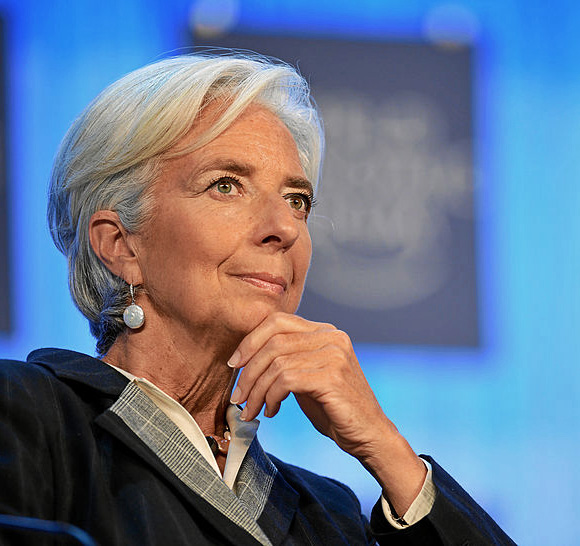 The short-term figures are lower than in the USA, France and Germany and reflect ‘the anticipated higher barriers to trade and lower foreign direct investment following Brexit’.
The short-term figures are lower than in the USA, France and Germany and reflect ‘the anticipated higher barriers to trade and lower foreign direct investment following Brexit’.
The report sounds some alarm bells for the global economy.
The first is a possible growth in trade barriers as a trade war looms between the USA and China and as Russia faces growing trade sanctions. As Christine Lagarde, managing director of the IMF told an audience in Hong Kong:
Governments need to steer clear of protectionism in all its forms. …Remember: the multilateral trade system has transformed our world over the past generation. It helped reduce by half the proportion of the global population living in extreme poverty. It has reduced the cost of living, and has created millions of new jobs with higher wages. …But that system of rules and shared responsibility is now in danger of being torn apart. This would be an inexcusable, collective policy failure. So let us redouble our efforts to reduce trade barriers and resolve disagreements without using exceptional measures.
 The second danger is a growth in world government and private debt levels, which at 225% of global GDP are now higher than before the financial crisis of 2007–9. With Trump’s policies of tax cuts and increased government expenditure, the resulting rise in US government debt levels could see some fiscal tightening ahead, which could act as a brake on the world economy. As Maurice Obstfeld , Economic Counsellor and Director of the Research Department, said at the Press Conference launching the latest World Economic Outlook:
The second danger is a growth in world government and private debt levels, which at 225% of global GDP are now higher than before the financial crisis of 2007–9. With Trump’s policies of tax cuts and increased government expenditure, the resulting rise in US government debt levels could see some fiscal tightening ahead, which could act as a brake on the world economy. As Maurice Obstfeld , Economic Counsellor and Director of the Research Department, said at the Press Conference launching the latest World Economic Outlook:
Debts throughout the world are very high, and a lot of debts are denominated in dollars. And if dollar funding costs rise, this could be a strain on countries’ sovereign financial institutions.
In China, there has been a massive rise in corporate debt, which may become unsustainable if the Chinese economy slows. Other countries too have seen a surge in private-sector debt. If optimism is replaced by pessimism, there could be a ‘Minsky moment’, where people start to claw down on debt and banks become less generous in lending. This could lead to another crisis and a global recession. A trigger could be rising interest rates, with people finding it hard to service their debts and so cut down on spending.
The third danger is the slow growth in labour productivity combined with aging populations in developed countries. This acts as a brake on growth. The rise in AI and robotics (see the post Rage against the machine) could help to increase potential growth rates, but this could cost jobs in the short term and the benefits could be very unevenly distributed.
 This brings us to a final issue and this is the long-term trend to greater inequality, especially in developed economies. Growth has been skewed to the top end of the income distribution. As the April 2017 WEO reported, “technological advances have contributed the most to the recent rise in inequality, but increased financial globalization – and foreign direct investment in particular – has also played a role.”
This brings us to a final issue and this is the long-term trend to greater inequality, especially in developed economies. Growth has been skewed to the top end of the income distribution. As the April 2017 WEO reported, “technological advances have contributed the most to the recent rise in inequality, but increased financial globalization – and foreign direct investment in particular – has also played a role.”
And the policy of quantitative easing has also tended to benefit the rich, as its main effect has been to push up asset prices, such as share and house prices. Although this has indirectly stimulated the economy, it has mainly benefited asset owners, many of whom have seen their wealth soar. People further down the income scale have seen little or no growth in their real incomes since the financial crisis.
Articles
- Clouds gather over global economy, casting long shadow on Europe
Politico, Pierre Briançon (18/4/18)
- IMF warns rising trade tensions threaten to derail global growth
Reuters, David Lawder (17/4/18)
- IMF outlook contains cause for celebration but a horrendous hangover is looming
The Guardian, Greg Jericho (18/4/18)
- World trade system in danger of being torn apart, warns IMF
The Guardian, Larry Elliott (17/4/18)
- IMF Warns of Rising Threats to Global Financial System
Bloomberg, Andrew Mayeda (18/4/18)
- IMF issues warning on global debt
BBC News, Andrew Walker (18/4/18)
- The IMF has a simple message: the global recovery will peter out
The Guardian, Larry Elliott (17/4/18)
- Global growth is built, alas, on shaky foundations
The Irish Times, Martin Wolf (18/4/18)
- Government debt
The Economist (19/4/18)
- This Is How Much Money the World Owes
Fortune (19/4/18)
Report
Data
Questions
- For what reasons may the IMF forecasts turn out to be incorrect?
- Why are emerging and developing countries likely to experience faster rates of economic growth than advanced countries?
- What are meant by a ‘positive output gap’ and a ‘negative output gap’? What are the consequences of each for various macroeconomic indicators?
- Explain what is meant by a ‘Minsky moment’. When are such moments likely to occur? Explain why or why not such a moment is likely to occur in the next two or three years?
- For every debt owed, someone is owed that debt. So does it matter if global public and/or private debts rise? Explain.
- What have been the positive and negative effects of the policy of quantitative easing?
- What are the arguments for and against using tariffs and other forms of trade restrictions as a means of boosting a country’s domestic economy?
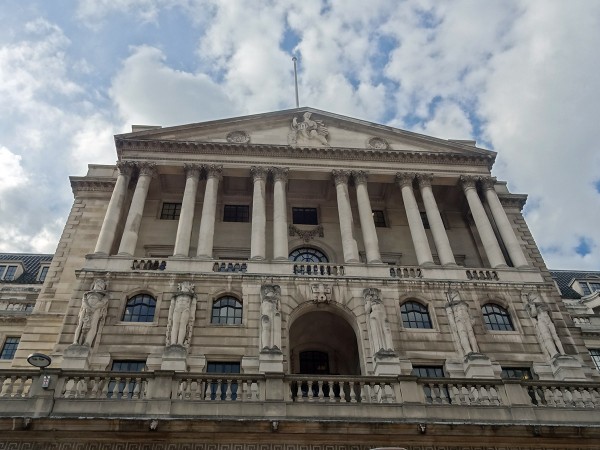 On 2 November, the Bank of England raised Bank rate from 0.25% to 0.5% – the first rise since July 2007. But was now the right time to raise interest rates? Seven of the nine-person Monetary Policy Committee voted to do so; two voted to keep Bank Rate at 0.25%.
On 2 November, the Bank of England raised Bank rate from 0.25% to 0.5% – the first rise since July 2007. But was now the right time to raise interest rates? Seven of the nine-person Monetary Policy Committee voted to do so; two voted to keep Bank Rate at 0.25%.
Raising the rate, on first sight, may seem a surprising decision as growth remains sluggish. Indeed, the two MPC members who voted against the rise argued that wage growth was too weak to justify the rise. Also, inflation is likely to fall as the effects of the Brexit-vote-induced depreciation of sterling on prices feeds through the economy. In other words, prices are likely to settle at the new higher levels but will not carry on rising – at least not at the same rate.
So why did the other seven members vote to raise Bank Rate. There are three main arguments:
|
|
| • |
Inflation, at 3%, is above the target of 2% and is likely to stay above the target if interest rates are not raised. |
| • |
There is little spare capacity in the economy, with low unemployment. There is no shortage of aggregate demand relative to output. |
| • |
With productivity growth being negligible and persistently below that before the financial crisis, aggregate demand, although growing slower than in the past, is growing excessively relative to the growth in aggregate supply. |
As the Governor stated at the press conference:
In many respects, the decision today is straightforward: with inflation high, slack disappearing, and the economy growing at rates above its speed limit, inflation is unlikely to return to the 2% target without some increase in interest rates.
But, of course, the MPC’s forecasts may turn out to be incorrect. Many things are hard to predict. These include: the outcomes of the Brexit negotiations; consumer and business confidence and their effects on consumption and investment; levels of growth in other countries and their effects on UK exports; and the effects of the higher interest rates on saving and borrowing and hence on aggregate demand.
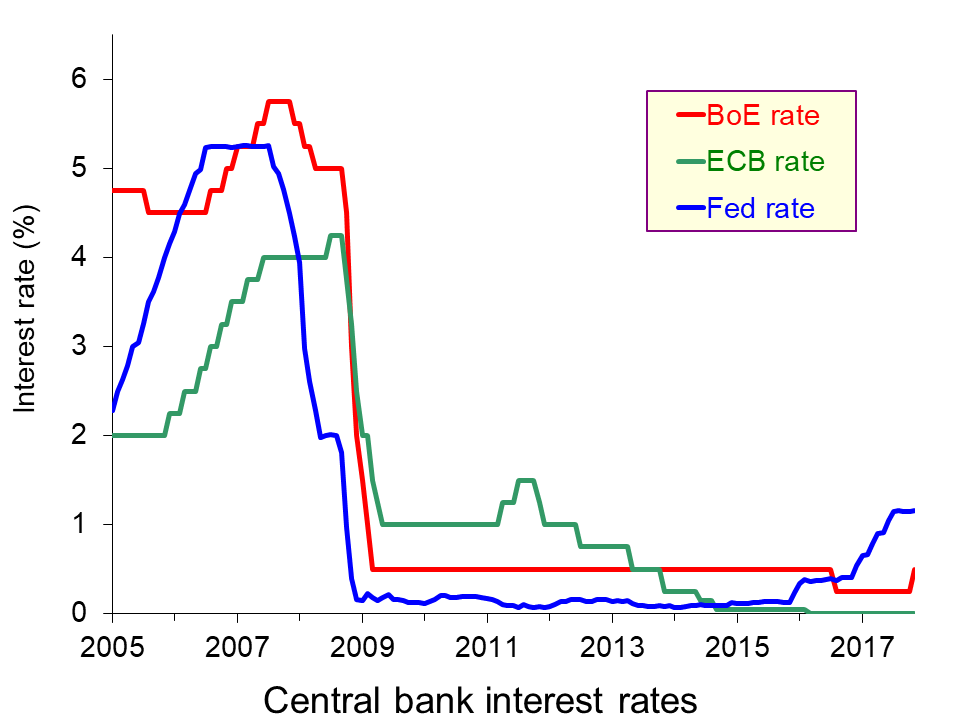 The Bank of England is well aware of these uncertainties. Although it plans two more rises in the coming months and then Bank Rate remaining at 1% for some time, this is based on its current assessment of the outlook for the economy. If circumstances change, the Bank will adjust the timing and total amount of future interest rate changes.
The Bank of England is well aware of these uncertainties. Although it plans two more rises in the coming months and then Bank Rate remaining at 1% for some time, this is based on its current assessment of the outlook for the economy. If circumstances change, the Bank will adjust the timing and total amount of future interest rate changes.
There are, however, dangers in the rise in interest rates. Household debt is at very high levels and, although the cost of servicing these debts is relatively low, even a rise in interest rates of just 0.25 percentage points can represent a large percentage increase. For example, a rise in a typical variable mortgage interest rate from 4.25% to 4.5% represents a 5.9% increase. Any resulting decline in consumer spending could dent business confidence and reduce investment.
Nevertheless, the Bank estimates that the effect of higher mortgage rates is likely to be small, given that some 60% of mortgages are at fixed rates. However, people need to refinance such rates every two or three years and may also worry about the rises to come promised by the Bank.
Articles
Bank of England deputy says interest rate rise means pain for households and more hikes could be in store Independent, Ben Chapman (3/11/17)
UK interest rates: Bank of England shrugs off Brexit nerves to launch first hike in over a decade Independent, Ben Chu (2/11/17)
 Bank of England takes slow lane after first rate hike since Reuters, David Milliken, William Schomberg and Julian Satterthwaite (2/11/17)
Bank of England takes slow lane after first rate hike since Reuters, David Milliken, William Schomberg and Julian Satterthwaite (2/11/17)
First UK rate rise in a decade will be a slow burn Financial Times, Gemma Tetlow (2/11/17)
The Bank of England’s Rate Rise Could Spook Britain’s Economy Bloomberg, Fergal O’Brien and Brian Swint (3/11/17)
 Bank of England hikes rates for the first time in a decade CNBC, Sam Meredith (2/11/17)
Bank of England hikes rates for the first time in a decade CNBC, Sam Meredith (2/11/17)
Interest rates rise in Britain for the first time in a decade The Economist (2/11/17)
Bank of England publications
 Bank of England Inflation Report Press Conference, Opening Remarks Financial Times on YouTube, Mark Carney (2/11/17)
Bank of England Inflation Report Press Conference, Opening Remarks Financial Times on YouTube, Mark Carney (2/11/17)
Bank of England Inflation Report Press Conference, Opening Remarks Bank of England, Mark Carney (2/11/17)
 Inflation Report Press Conference (full) Bank of England on YouTube (2/11/17)
Inflation Report Press Conference (full) Bank of England on YouTube (2/11/17)
Inflation Report Bank of England (November 2017)
Monetary Policy Summary and minutes of the Monetary Policy Committee meeting ending on 1 November 2017 Bank of England (2/11/17)
Questions
- Why did the majority of MPC members feel that now was the right time to raise interest rates whereas a month ago was the wrong time?
- Why did the exchange rate fall when the announcement was made?
- How does a monetary policy of targeting the rate of inflation affect the balance between aggregate demand and aggregate supply?
- Can monetary policy affect potential output, or only actual output?
- If recent forecasts have downgraded productivity growth and hence long-term economic growth, does this support the argument for raising interest rates or does it suggest that monetary policy should be more expansionary?
- Why does the MPC effectively target inflation in the future (typically in 24 months’ time) rather than inflation today? Note that Mark Carney at the press conference said, “… it isn’t so much where inflation is now, but where it’s going that concerns us.”
- To what extent can the Bank of England’s monetary policy be described as ‘discretionary’?
 The UK government has made much of its spending commitments in the UK Budget and Spending Review delivered on 27 October 2021. Spending on transport infrastructure, green energy and health care figured prominently. The government claimed that these were to help achieve its objectives of economic growth, carbon reduction and ‘levelling up’. This means that government expenditure will be around 42% of GDP for the five years from 2022 (from 1988 to 2000 it averaged 36%). Although it temporarily rose to 52% in 2020/21, this was the result of supporting the economy through the pandemic. But does this mean that the government is now a ‘Keynesian’ one?
The UK government has made much of its spending commitments in the UK Budget and Spending Review delivered on 27 October 2021. Spending on transport infrastructure, green energy and health care figured prominently. The government claimed that these were to help achieve its objectives of economic growth, carbon reduction and ‘levelling up’. This means that government expenditure will be around 42% of GDP for the five years from 2022 (from 1988 to 2000 it averaged 36%). Although it temporarily rose to 52% in 2020/21, this was the result of supporting the economy through the pandemic. But does this mean that the government is now a ‘Keynesian’ one? As you can see, there was a large increase in the PSNB in 2020/21, reflecting the government’s measures to support firms and workers during the pandemic. (Click here for a PowerPoint of the chart.) This was very much a Keynesian response, where a large budget deficit was necessary to support aggregate demand. It was also to protect the supply side of the economy by enabling firms to survive.
As you can see, there was a large increase in the PSNB in 2020/21, reflecting the government’s measures to support firms and workers during the pandemic. (Click here for a PowerPoint of the chart.) This was very much a Keynesian response, where a large budget deficit was necessary to support aggregate demand. It was also to protect the supply side of the economy by enabling firms to survive. But could the October 2021 announcements also be seen as a Keynesian response to the macroeconomic situation? If we redraw Chart 1, focusing just on the forecast period and adjust the vertical scale, we can see that the measures have a net effect of increasing the PSNB and thus acting as a stimulus to aggregate demand. (Click here for a PowerPoint of the chart.) The figures are shown in the following table, which shows the totals from Table 5.1 in the Autumn Budget and Spending Review 2021 document:
But could the October 2021 announcements also be seen as a Keynesian response to the macroeconomic situation? If we redraw Chart 1, focusing just on the forecast period and adjust the vertical scale, we can see that the measures have a net effect of increasing the PSNB and thus acting as a stimulus to aggregate demand. (Click here for a PowerPoint of the chart.) The figures are shown in the following table, which shows the totals from Table 5.1 in the Autumn Budget and Spending Review 2021 document:
 So what is the forecast for the output gap? The OBR states that, after being negative in 2020
So what is the forecast for the output gap? The OBR states that, after being negative in 2020 The government is hoping that the rise in government expenditure will have beneficial supply-side effects and increase potential national income. The aim is to create a high-wage, high-skilled, high-productivity economy though investment in innovation, infrastructure and skills. As the OBR states, ‘The rebounding economy has provided the Chancellor with a Budget windfall that he has added to with tax rises that lift the tax burden to its highest since the early 1950s’.
The government is hoping that the rise in government expenditure will have beneficial supply-side effects and increase potential national income. The aim is to create a high-wage, high-skilled, high-productivity economy though investment in innovation, infrastructure and skills. As the OBR states, ‘The rebounding economy has provided the Chancellor with a Budget windfall that he has added to with tax rises that lift the tax burden to its highest since the early 1950s’. Autumn Budget and Spending Review 2021
Autumn Budget and Spending Review 2021 One of the major economic concerns about the COVID-19 pandemic has been the likely long-term scarring effects on economies from bankruptcies, a decline in investment, lower spending on research and development, a loss of skills, discouragement of workers, disruption to education, etc. The result would be a decline in potential output or, at best, a slower growth. These persistent effects are known as ‘hysteresis’ – an effect that persists after the original cause has disappeared.
One of the major economic concerns about the COVID-19 pandemic has been the likely long-term scarring effects on economies from bankruptcies, a decline in investment, lower spending on research and development, a loss of skills, discouragement of workers, disruption to education, etc. The result would be a decline in potential output or, at best, a slower growth. These persistent effects are known as ‘hysteresis’ – an effect that persists after the original cause has disappeared.  The first is that the pandemic may have hastened the process of digitalisation and automation. Examples include ‘video conferencing and file sharing applications to drones and data-mining technologies’. According to evidence from a sample of 15 countries cited in the blog, a 10% rise in such intangible capital investment is associated with about a 4½% rise in labour productivity. ‘As COVID-19 recedes, the firms which invested in intangible assets, such as digital technologies and patents may see higher productivity as a result.’
The first is that the pandemic may have hastened the process of digitalisation and automation. Examples include ‘video conferencing and file sharing applications to drones and data-mining technologies’. According to evidence from a sample of 15 countries cited in the blog, a 10% rise in such intangible capital investment is associated with about a 4½% rise in labour productivity. ‘As COVID-19 recedes, the firms which invested in intangible assets, such as digital technologies and patents may see higher productivity as a result.’ The OECD has recently published its six-monthly
The OECD has recently published its six-monthly  The OECD forecasts that potential economic growth will be negative in 2021, with capacity declining by 0.4 per cent. Only two other OECD countries, Italy and Greece, are forecast to have negative potential economic growth (see Table 24 in the Statistical Annex). A rapid increase in aggregate demand, accompanied by a decline in aggregate supply, could result in inflationary pressures, even if initially there is considerable slack in some parts of the economy.
The OECD forecasts that potential economic growth will be negative in 2021, with capacity declining by 0.4 per cent. Only two other OECD countries, Italy and Greece, are forecast to have negative potential economic growth (see Table 24 in the Statistical Annex). A rapid increase in aggregate demand, accompanied by a decline in aggregate supply, could result in inflationary pressures, even if initially there is considerable slack in some parts of the economy. The scarring effects of the pandemic present another problem. There has been a decline in investment. Even if this is only temporary, it will have a long-term impact on capacity, unless there is a compensating rise in investment in the future. Many businesses have closed and will not re-open, including many High Street stores. Moves to working from home, even if partially reversed as the economy unlocks, will have effects on the public transport industry. Also, people may have found new patterns of consumption, such as making more things for themselves rather than buying them, which could affect many industries. It is too early to predict the extent of these scarring effects and how permanent they will be, but they could have a dampening effect on certain sectors.
The scarring effects of the pandemic present another problem. There has been a decline in investment. Even if this is only temporary, it will have a long-term impact on capacity, unless there is a compensating rise in investment in the future. Many businesses have closed and will not re-open, including many High Street stores. Moves to working from home, even if partially reversed as the economy unlocks, will have effects on the public transport industry. Also, people may have found new patterns of consumption, such as making more things for themselves rather than buying them, which could affect many industries. It is too early to predict the extent of these scarring effects and how permanent they will be, but they could have a dampening effect on certain sectors. As far as as the housing market is concerned, the rise in demand has been fuelled by the
As far as as the housing market is concerned, the rise in demand has been fuelled by the  The IMF has just published its six-monthly
The IMF has just published its six-monthly  The short-term figures are lower than in the USA, France and Germany and reflect ‘the anticipated higher barriers to trade and lower foreign direct investment following Brexit’.
The short-term figures are lower than in the USA, France and Germany and reflect ‘the anticipated higher barriers to trade and lower foreign direct investment following Brexit’. The second danger is a growth in
The second danger is a growth in  This brings us to a final issue and this is the long-term trend to greater inequality, especially in developed economies. Growth has been skewed to the top end of the income distribution. As the
This brings us to a final issue and this is the long-term trend to greater inequality, especially in developed economies. Growth has been skewed to the top end of the income distribution. As the 
